The example problems presented in this document are provided to encourage you to take advantage of the extraordinarily broad simulation capabilities of Ansys Mechanical and Ansys Workbench. The real-world problems showcase the power of Ansys Mechanical to simulate and accurately solve interdisciplinary problems from a variety of industries and engineering fields.
The problems are more substantive and complex than examples found in the standard documentation set. The documentation examines the underlying physics of each problem and the considerations necessary to simulate these problems with numerical models. Approximation issues, accuracy considerations, and recommended practices are discussed. Examining these example problems is an effective way to learn powerful features that you can customize to create unique, accurate simulations that help you design optimal solutions to your own problems.
How Problems Are Presented
Each problem description provides information about the nature and physical characteristics of the problem, specific modeling techniques, material properties, boundary conditions and loading, analysis details and solution controls.
A comprehensive results and discussion section carefully examines analysis results and illustrates why specific strategies and methods were chosen.
Each problem concludes with valuable hints and recommendations for performing a similar type of analysis. In many cases, references are provided for additional background information. Using these examples as templates, you can tailor them to specify and set up customized simulations to address your needs.
Your Results May Vary Slightly
The results shown for each problem may differ slightly from those that you obtain, depending upon the computer hardware and operating system platforms used and the Ansys software version, as default settings may affect results. Problems that were created in a previous version that are sensitive to default settings that optimize meshing may include a *.mechdat file in the input files. You can redo the analysis using the *.mechdat to get matching results.
Use of Ansys Mechanical Assumed
The problem descriptions here are solved using the Mechanical Application. To see these examples solved using Mechanical APDL see Technology Showcase: Example Problems.
Obtaining the Input Files
Every example problem has a Workbench Project Archive file available for download so that you can examine and explore hands-on the demonstrated features and options within Ansys Mechanical and Ansys Workbench. Most examples also have one or more input files that can be used to compare different modeling strategies. Links for the downloads can be found in the Workbench Input Files and Project Files section at the end of each example problem or in the summary table below.
Downloads are .zip files containing the relevant files for that particular problem. After downloading a .zip file, extract the contents to a convenient location on your computer.
Workbench Project Archive (.wbpz) files can be very large and may take a long time to download. Input files are contained in a single .zip file for each example. The contents of the .zip files vary from problem to problem (they may include complex geometry CAD files, mesh files, database files, etc.) and originate from different modeling and simulation software products (SpaceClaim, DesignModeler, and Mechanical APDL, etc.). For procedures describing how to open various input files, see Attach Geometry/Mesh in the Mechanical User's Guide.
Problem Summary
The following example problems are described in this Showcase:
| td-1
No input files available |
Brake-Squeal Analysis
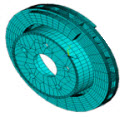
| Solves a brake squeal problem. Three analysis methods are highlighted: linear non-prestressed modal, partial nonlinear prestressed modal, and full nonlinear prestressed modal. The problem demonstrates sliding frictional contact and uses complex eigensolvers to predict unstable modes. |
| td-4 |
Ring-Gear Forging Simulation with
Rezoning

| Demonstrates the efficiency and usefulness of rezoning in a 2-D simulation of metal-forming processes. Rezoning facilitates the convergence of a nonlinear finite element simulation in which excessive element distortion occurs. |
| td-5 |
Delamination of a Stiffened Composite Panel Under
a Compressive Load
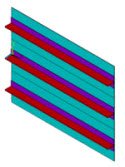
| Uses solid-shell element technology to model a layered-composite structure. The problem simulates interface delamination through the debonding capability of contact elements. |
| td-6 |
Thermal Stress Analysis of a Cooled
Turbine Blade

| Shows how to easily set up and perform a thermal-stress analysis of a cooled turbine blade. The problem uses surface-effect capabilities to simulate convection loading on solid regions, and one-dimensional fluid-flow capabilities to obtain a highly accurate thermal solution for convection loading. |
| td-8 |
Nuclear Piping System Under Seismic
Loading

| Demonstrates the advantages of elbow element technology over traditional shell and pipe element technology for modeling pipe bends in a typical nuclear piping system. |
| td-15 |
Calibrating and Validating a Hyperelastic
Constitutive Model

| Uses hyperelastic curve-fitting to select constitutive model parameters to fit experimental data. Several issues influencing the accuracy of the curve fit are discussed. Validation of the resulting constitutive model is demonstrated by comparison with a tension-torsion experiment. |
| td-16 |
Evaluation of Mixed-Mode
Stress Intensity Factors and T-stress for 3-D Surface Flaws
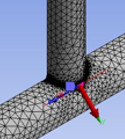
| Demonstrates the linear elastic fracture mechanics of 3-D structures. The problem shows how fracture mechanics can be used to evaluate mixed-mode stress-intensity factors, J-integrals, and T-stresses. Analyses of a simple semicircular surface flaw in a rectangular block and a warped flaw along a tubular joint are discussed. |
| td-17
No input files available |
Impact of a Metal Bar on a Rigid Wall
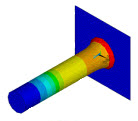
| An impact simulation using a model of a 3-D metal bar hitting a rigid wall. The problem shows the advantages of using impact constraints for modeling contact in a nonlinear transient dynamic analysis. Several combinations of available time-integration methods and contact algorithms are also investigated, using different material models to show how various choices affect the performance and accuracy of the finite-element solution of impact problems. |
| td-18 |
Viscoelastic Analysis of an All-Ceramic Fixed
Partial Denture (FPD)

| Demonstrates the fictive-temperature model using the Tool-Narayanaswamy (TN) shift function to study residual stresses in an all-ceramic fixed partial denture (FPD). A coupled-field solution process, including transient thermal and nonlinear structural analyses, is used. |
| td-26 |
Nonlinear Analysis of a Rubber Boot Seal
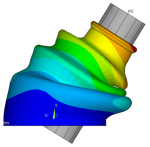
| A nonlinear analysis of a rubber boot seal that includes geometric nonlinearities (large strain and large deformation), nonlinear material behavior (incompressible hyperelastic material model), and changing status nonlinearities (contact). The analysis demonstrates the advantages of the surface-projection-based contact contact method. |
| td-27 |
Hot-Rolling Structural Steel Analysis with
Nonlinear Mesh Adaptivity
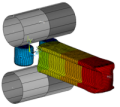
| A 3-D large-deformation problem demonstrating the use of Nonlinear Mesh Adaptivity to automatically repair a severely distorted mesh during simulation and achieve solution convergence. The example also uses contact technology. |
| td-28 | Friction Stir Welding
(FSW) Simulation  | Simulates the friction stir welding (FSW) process. Several characteristics of FSW are presented, including plastic deformation, tool-workpiece surface interaction, and heat generation due to friction and plastic deformation. Thermal and mechanical behaviors are mutually dependent and coupled together during the FSW process. A nonlinear direct coupled-field analysis is performed. |
| td-29 | Rocket Nozzle Extension
Simulation: Operation 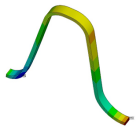 | Simulates the thermal stresses induced during the operation of a rocket nozzle. Hot gases flow through the nozzle, subjecting the inside and outside of the nozzle body to convection heat loading. Solid thermal and structural elements accurately simulate the multiphysics of the problem. |
| td-31 |
Fitting
Parameters for a Chaboche Kinematic Hardening Model
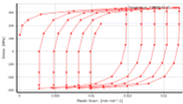
| Determines material parameters for a third-order Chaboche
kinematic hardening model using the curve-fitting tool. A method is presented to estimate the initial parameters and obtain a least-squares best fit to the data. The fitted parameters are validated by conducting uniaxial simulations using a single element and comparing the results with the experimental data. |
| td-33 |
Analysis of a Piezoelectric Flextensional Transducer in Water

|
Couples structural, piezoelectric, and acoustic elements to analyze the acoustic response of a flextensional transducer to voltage excitation. The problem highlights fluid-structure interaction (FSI), piezoelectric materials, infinite acoustic elements, the Robin boundary condition, and far-field postprocessing. |
| td-35 |
Elastoplastic Creep Analysis of Lead-Free
Solder Bumps

| A thermomechanical analysis of lead-free solder bumps subjected to cyclic thermal loading. The problem shows how to obtain implicit creep material constants using experimental data, uses creep and plasticity material models to simulate viscoplastic behavior, and determines accumulated creep strain due to thermal loading. |
| td-37 |
Bolt Thread Simulation

| A comparison of three modeling techniques for bolt threading: true threading simulation, the bolt section method, and the multi-point constraint (MPC) method. The comparison shows that the bolt section method offers accurate results while requiring significantly less computational time. |
| td-39 |
Wire Bonding Ultrasonic Transducer

| Simulates electrical excitation of an ultrasonic transducer used for wire bonding applications. Includes piezoelectric material definition, and prestressed modal and harmonic-response analyses. |
| td-40 | ||
| td-41 No input files available |
Acoustic
Analysis of a Viscothermal Resonator
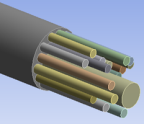
| Uses acoustic elements and viscothermal losses comparing the boundary layer impedance (BLI) model and the low reduced frequency (LRF) model to analyze the noise reduction of sound-absorbing trim panels with quarter-wave resonators. |
| td-42 |
Wire Crimping Modeled with General Contact
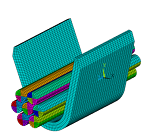
| Demonstrates the ease of contact modeling using the general contact method. The method offers automated contact creation and requires minimal user input. It is especially useful when the model has a large number of contacting surfaces and the geometry makes it difficult to determine contact pairs. |
| td-43 |
Contact Surface Wear
Simulation
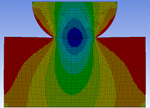
| Demonstrates how to model contact surface wear using the Archard wear model. The wear model calculates how much, and in what direction, a contact node is to be moved to simulate wear based on the contact results. Nonlinear mesh adaptivity based on a wear criterion is used to improve the mesh during the wear process. |
| td-44 |
C*-integral Evaluation for 3-D
Surface Flaws
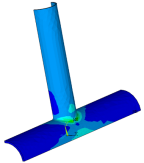
| Evaluates the C*-integral for cracks in structural components. Analyses of a simple semicircular surface flaw in a rectangular block and a warped flaw along a tubular joint are presented. |
| td-47 |
Electromigration in a
Solder Ball
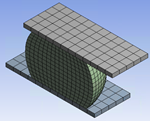
| A transient electromigration analysis of a solder ball. The coupled-field solution calculates the deviation in atomic concentration from an initial unit value due to the combined effects of diffusion, electromigration, stress migration, and thermomigration. |
| td-48 |
Active and Passive Lateral
Earth Pressure Analysis

| Simulates soil behavior under active and passive earth-pressure loadings. Shows how the nonlinear plastic behavior of soil can be modeled with a Mohr-Coulomb material. |
| td-49 | Load Limit Analysis of a Reinforced
Concrete Slab
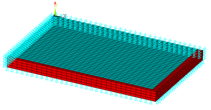
| A load-limit analysis of a reinforced concrete slab showing how the nonlinear plastic behavior of concrete can be modeled using a modified Drucker-Prager and a Menetrey-Willam material. |
| td-51 |
Multi-Filar Coil Inside a
Tube Modeled with Beam-to-Beam Contact
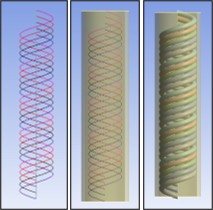
| Three methods for modeling a multi-filar coil inside of a tube. Each model uses a different contact scenario: surface-to-surface, beam-to-surface, or beam-to-beam. A comparison shows that the beam model using beam-to-beam contact offers the best advantage in terms of simplified modeling and reduced computation time. |
| td-53 | Acoustic Analysis of a MEMS
Microphone
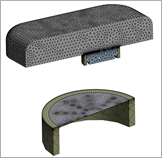
| Analyzes the response of a silicon micro-machined microphone using acoustic elements and electrostatic-structural coupled-field elements. |
| td-55 |
Inverse-Solving Analysis of a Rotor Fan Blade
with Disk
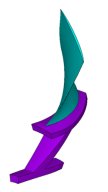
| A simulation of a rotor fan blade with disk using a nonlinear static analysis with inverse solving to obtain the cold geometry from the hot geometry in a single solution. |
| td-56 No input files available |
Threaded Connection
Analysis
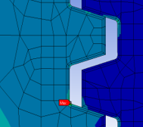 | A threaded-pipe connection analysis demonstrating the capabilities and advantages of a 2-D to 3-D analysis. The analysis requires extending a 2-D model solution to a corresponding extruded 3-D body so that the solution can continue based on the 3-D model. |
| td-58 |
Suction Pile
Analysis
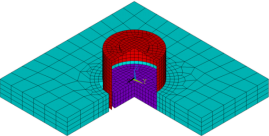 | Simulates the interaction between a soil environment and a steel suction-pile structure. The nonlinear plastic behavior of soil is modeled using a Mohr-Coulomb material. The problem examines the influence of imperfections on the structural response. |
| td-59 |
Thermal-Structural Analysis of a Printed Circuit Board
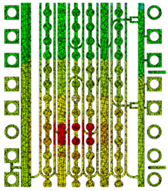
| Uses mesh-independent reinforcements in a thermal-structural analysis of a printed circuit board (PCB). The model includes both discrete and smeared reinforcing. The problem solution involves a thermal analysis followed by a downstream structural analysis. |


